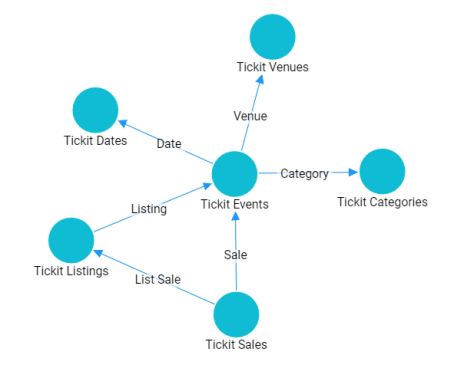Introduction to Model Concepts
Models define the business meaning of the source data. They describe the concepts, attributes, and relationships in or across data sets. Instead of reflecting the format or schema of the source data, models reflect the desired structure of the data after it is onboarded to Anzo. Anzo links data to models to provide flexibility for capturing data coming from various sources and structures and to enable users to search for and visualize data in Hi-Res Analytics dashboards or other applications. Users can import existing or external models (OWL ontologies) to Anzo, and models can be shared and reused.
The following image shows a portion of the model for a data set that captures sales activity for a fictional website where people buy and sell tickets for sporting events, shows, and concerts.

Model Vocabulary
The table below defines key terms to know when working with models.
| Term | Description |
|---|---|
| Class | Models are made up of classes. Classes describe a concept or a group of related objects. For example, the model above contains Tickit Events, Tickit Dates, Tickit Categories, Tickit Sales, and Tickit Listings classes. |
| Base Class | A base class is a more general version of a class. For example, a film model might have a Person base class with subclasses that categorize types of people. |
| Subclass | A subclass is a more specific version of another class. For example, in a film model a Person class might have subclasses of Actors, Directors, and Producers. Subclasses share the properties from the base class and can include additional properties. |
| Property | Properties are attributes that describe the data in a class. For example the Tickit Events class has properties such as eventName, dateID, and startTime. There are two types of properties:
|
| Property Type | A property type is the data type of the values for the property, also known as the Property Range. |
| Instance | Instances are concrete occurrences of a class. For example, an event's name is an instance of the Tickit Events class. |
| Simple Value | A simple value is also known as a literal value. The list below describes literal values:
|
| Type | Either a class or a simple value. |